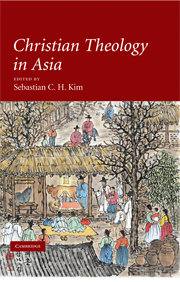Book contents
- Frontmatter
- Contents
- Contributors
- Preface and Acknowledgements
- 1 FORMATION OF CHRISTIAN THEOLOGIES IN ASIA
- II THEOLOGICAL THEMES OF CHRISTIANITY IN ASIA
- 8 Religious pluralism, dialogue and Asian Christian responses
- 9 Cross-textual hermeneutics and identity in multi-scriptural Asia
- 10 Re-constructing Asian feminist theology: toward a glocal feminist theology in an era of neo-Empire(s)
- 11 The ecumenical movement in Asia in the context of Asian socio-political realities
- 12 Mission and evangelism: evangelical and pentecostal theologies in Asia
- 13 Subalterns, identity politics and Christian theology in India
- Index
- References
9 - Cross-textual hermeneutics and identity in multi-scriptural Asia
Published online by Cambridge University Press: 05 June 2012
- Frontmatter
- Contents
- Contributors
- Preface and Acknowledgements
- 1 FORMATION OF CHRISTIAN THEOLOGIES IN ASIA
- II THEOLOGICAL THEMES OF CHRISTIANITY IN ASIA
- 8 Religious pluralism, dialogue and Asian Christian responses
- 9 Cross-textual hermeneutics and identity in multi-scriptural Asia
- 10 Re-constructing Asian feminist theology: toward a glocal feminist theology in an era of neo-Empire(s)
- 11 The ecumenical movement in Asia in the context of Asian socio-political realities
- 12 Mission and evangelism: evangelical and pentecostal theologies in Asia
- 13 Subalterns, identity politics and Christian theology in India
- Index
- References
Summary
INTRODUCTION
The multi-scriptural phenomenon of Asian cultures and religions has presented a problem and a challenge to the reading of the Bible, by Asian Christians, from the time of the colonial era. In order to justify the existence of and uphold the credibility of the missionary movement, which was part of the whole colonial project of the empire, the basic missionary strategy was set to undermine and even condemn the living traditions of Asian religions and their respective scriptures. The impact of such a strategy was tremendous on the Asian Christian converts who could not afford to ignore the reality of the plurality of texts. Their new identity as Christians threw their Asian religio-cultural identity into confusion and head-on collision. In this historical situation of the spread of Christianity to the east, conflicts of the Bible with local religions and their scriptures gave rise to the suppression of the native. The very encounter of the different living scriptural traditions should have provided an exciting melting pot for the reading and re-reading of both the Christian Bible and the other Asian scriptures, if the Asian Christians were ever encouraged to interpret their cultural heritage in the face of the foreign canon and to appropriate the Bible in the context of a multi-scriptural environment. The Bible and other Asian texts have attracted the attention of postcolonial research, since the Bible and its interpretation in Asia have been an enlightening topic ever since the colonial era.
- Type
- Chapter
- Information
- Christian Theology in Asia , pp. 179 - 204Publisher: Cambridge University PressPrint publication year: 2008
References
- 2
- Cited by



